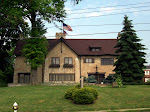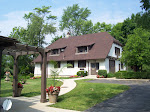The Mahoning Valley Historical Society will be hosting a panel discussion entitled
Discovering African-American History in the Mahoning Valley on Saturday, February 21st at 4:00 p.m. The discussion will include community historians actively researching and disseminating information about important people, places and events in the Mahoning Valley’s African American community; panel will include Stacey Adger, Steffon Jones, Vince Shivers, Judy Williams and Bill Lawson as moderator.
This free event will be held in the MVHS Carriage House, behind the Arms Family Museum, 648 Wick Avenue in Youngstown. Support for this program is provided by the Ruth H. Beecher Charitable Trust.
Panelist Vince Shivers has been exploring the life of P. Ross Berry, an influential African-American architect from Youngstown whose legacy includes important buildings such as the current home of the Board of Education and the Helen Chapel of the First Presbyterian Church of downtown Youngstown.
Plimton Ross Berry

P. Ross Berry (1835-1917) was the masonry contractor for many of the most significant buildings in the Mahoning Valley during the late 19th century. Born a free man in Lawrence County, Pennsylvania, he began his career as a bricklayer at the young age of 16. At that time, Berry was commissioned by Lawrence County to do the brickwork for a new courthouse in New Castle, Pennsylvania. Ten years later, Berry and wife Mary traveled by boat to Youngstown after he was awarded the brickwork contract for the Rayen School (now the Youngstown Board of Education building.) During his forty year career in Youngstown, Berry became recognized as a master builder and respected citizen of the Mahoning Valley.

Berry proved himself to be an experienced and devoted bricklayer. While building the original Rayen School (now the Youngstown Board of Education Building), he simultaneously built second Saint Columba sanctuary. Other buildings included the Youngstown Opera House, the 1866 jail on Hazel Street, the 1876 Mahoning County Courthouse, the Tod House Hotel and many others. His masonry work included the Homer Hamilton & Company Foundry and Machine Shop and the Dollar Bank Building.

During his career in Youngstown, Berry contributed heavily to the growth of religious institutions in the Valley when he was commissioned to build three major churches including St. Columba, First Presbyterian, and First Baptist Temple.
With his partner, Lemuel Stewart, Berry built a legacy that would last into the present. Stewart was a building contractor who moved to the Mahoning Valley after Berry. The Stewart and Berry families were connected by both friendship and marriage and their sons continued as builders in the Youngstown area. Berry’s own four sons were trained as brick masons and later became union organizers of the Brick Masons Local #8.

Members of the Berry family were also the driving force behind the founding of St. Augustine’s Church in 1907. Today, many descendents of the Berry family belong to this church. P. Ross Berry greatly contributed to the building boom that occurred in Youngstown at the turn of the century, not just with bricks and stone, but with a family and descendents who have contributed greatly to the history and heritage of our community.
 Tokens of Affection, an exhibit of historic Valentine cards and postcards is on display now at the Arms Family Museum of Local History.
Tokens of Affection, an exhibit of historic Valentine cards and postcards is on display now at the Arms Family Museum of Local History.













